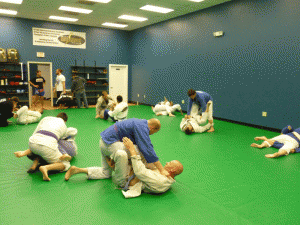 Instructors will often tell their students to roll “technically.” What does this really mean? It is rarely articulated.
Instructors will often tell their students to roll “technically.” What does this really mean? It is rarely articulated.
At its core, jiu jitsu is all about leverage. A tiny person can defeat a much larger opponent in spite of an incredible strength discrepancy through the use of simple Newtonian physics, concepts all schoolchildren learn at an early age. Simple enough, right?
However, where things become a little tricky is in the implementation of leverage. How do you actually become proficient at applying leverage in situations you might otherwise find incredibly stressful?
When you are doing “live rolling” (sometimes called randori or newaza, depending on your background), the objective when trying to execute a technique should always be to use virtually no strength when attempting to apply the technique. If you are using a significant amount of strength in order to achieve your position or submission, you are never going to be certain that you are using proper technique. Further, when your strength is matched or exceeded by an opponent when it really matters- in a self defense or competition setting- you may completely fail if you’re relying on being stronger than your opponent.
On the other hand, if you start attempting to execute a technique with virtually no strength applied, and it works, try it again with a similar level of effort applied to the movement against a different partner, or simply ask your current partner to give you some resistance as you apply the same technique again. If you can still get the move, odds are that you are using proper technique.
This strategy may make for an uphill battle in the short term, but in the long term, you will not only have a deeper understanding of grappling, you’ll also have a lot more training partners who appreciate your style!